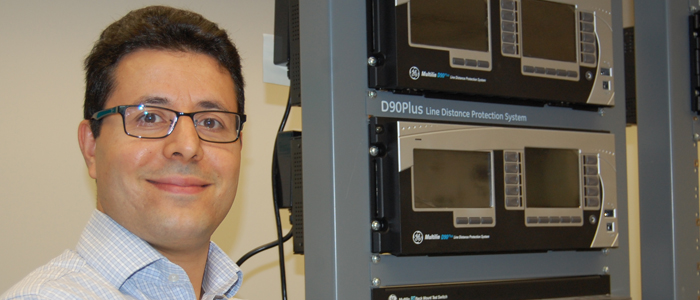Media
Contact
Communications Specialist
Faculty of Engineering
Spencer Engineering Building
Room 2072
Western University
Tel: 519-661-2111 ext. 87015
Email: engineeringcomms@uwo.ca
Protecting renewable energy sources from electrical distribution faults

Western Engineering News | October 28, 2014
By Jason Teakle
Mohammad Dadash Zadeh is investigating how to protect Ontario’s renewable energy infrastructure, such as solar panels and wind turbines, from faults, which affect power generation and distribution.
Dadash Zadeh, Electrical and Computer Engineering assistant professor and senior member of the Institute of Electrical and Electronics Engineers (IEEE), is leading a research project funded by Hydro One to create more complex and intelligent power distribution system protection methods, as more renewable energy sources are brought onboard.
"Now that we are adding more and more renewable resources to our distribution system, the power flow within the system will drastically change, making the distribution system have a bi-directional energy exchange between utilities and renewables," said Dadash Zadeh.
The development of the existing energy system was based on the design of power only flowing in one direction – from the utility to the customer. As renewables are added to the system, the protection system operation is disturbed.
Within the power system, individual equipment, such as generators, transformers, transmission lines and distribution lines, needs to be protected from faults in the system, he said.
“For each piece of equipment, there are protection systems in place,” he said, noting these are like the “brains of the system,” which detect faults and take appropriate actions to isolate faulted components or devices in the system.
Currently, renewables are disconnected whenever faults occur in the system. However, this results in a loss of renewable generation. Meanwhile renewables could potentially produce energy in a time of fault, he explained.
“Energy suppliers are trying to maintain renewables in the system without compromising the supply of electricity to customers,” said Dadash Zadeh. “This means (suppliers) have to upgrade their protection systems. Currently, Hydro One disconnects all renewables when faults happen, which raises considerable complaints and concerns from the owners of the renewables.
“The first step with Hydro One is to develop the proper models of renewables for power system protection studies. Once the models are available, we will use them to investigate the existing protection system, assuming that renewables are not supposed to be disconnected when faults happen.”
Dadash Zadeh said he plans to continue working closely with industry to implement his findings.
"Once the new protection techniques are prototyped in the lab, I will extend my collaboration with electricity relay manufacturing companies to implement new protection techniques of renewables in the distribution system," explained Dadash Zadeh. "The outcome of this project will help Hydro One implement a solution, which allows protection of the distribution system while renewables continue to operate during faults."

